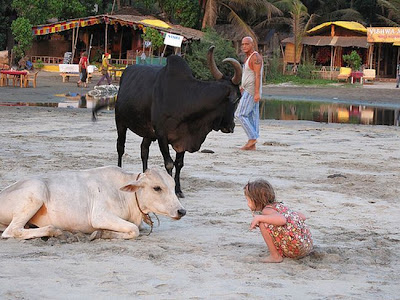 After our visits in Sedona we drove to Flagstaff and found a very nice RV place there by the Meteorite Crater. In the picture you can see the 4 mile long road up to the crater and in the back the San Francisco Mountains with snow
After our visits in Sedona we drove to Flagstaff and found a very nice RV place there by the Meteorite Crater. In the picture you can see the 4 mile long road up to the crater and in the back the San Francisco Mountains with snowThe San Francisco Peaks
are a volcanic mountain range located in north central Arizona, United States, just north of Flagstaff. The highest summit in the range, Humphreys Peak, is the highest point in the state of Arizona at 12,633 feet (3,851 m). The San Francisco Peaks (known locally as simply "the Peaks") are the remains of an eroded stratovolcano. An aquifer within the caldera supplies much of Flagstaff's water while the mountain itself is located within the Coconino National Forest and is the site of much outdoor recreation. The internationally known Arizona Snowbowl is located on the western slopes of the Mountain.
 An Apollo test capsule sits outside as another photo-op -- the moon astronauts trained here for their flight to the moon
An Apollo test capsule sits outside as another photo-op -- the moon astronauts trained here for their flight to the moon The origin of this classic simple meteorite impact crater was long the subject of controversy. The discovery of fragments of the Canyon Diablo meteorite, including fragments within the breccia deposits that partially fill the structure, and a range of shock metamorphic features in the target sandstone proved its impact origin. Target rocks include Paleozoic carbonates and sandstones; these rocks have been overturned just outside the rim during ejection. The hummocky deposits just beyond the rim are remnants of the ejecta blanket. This aerial view shows the dramatic expression of the crater in the arid landscape. (Courtesy of USGS/D. Roddy and LPI)
The origin of this classic simple meteorite impact crater was long the subject of controversy. The discovery of fragments of the Canyon Diablo meteorite, including fragments within the breccia deposits that partially fill the structure, and a range of shock metamorphic features in the target sandstone proved its impact origin. Target rocks include Paleozoic carbonates and sandstones; these rocks have been overturned just outside the rim during ejection. The hummocky deposits just beyond the rim are remnants of the ejecta blanket. This aerial view shows the dramatic expression of the crater in the arid landscape. (Courtesy of USGS/D. Roddy and LPI) This is a display of the largest fragment of Meteor Crater meteorite to survive, a comparatively puny 1,400-pound blob. The adjacent gift shop sells "Crater Dust" for ten bucks a baggie, and tosses in a magnet so that the mining-minded can extract the particles of space rock.
This is a display of the largest fragment of Meteor Crater meteorite to survive, a comparatively puny 1,400-pound blob. The adjacent gift shop sells "Crater Dust" for ten bucks a baggie, and tosses in a magnet so that the mining-minded can extract the particles of space rock. The sky is burning
The sky is burningAt 7:17 AM on the morning of June 30, 1908, a mysterious explosion occurred in the skies over Siberia. It was caused by the impact and breakup of a large meteorite, at an altitude roughly six kilometers in the atmosphere. Realistic pictures of the event are unavailable. However, Russian scientists collected eyewitness accounts of the event. I believe that we now know enough about large impacts to "decode" the subjective descriptions of the witnesses and create realistic views of this historic asteroid impact as seen from different distances.
You can get a sense of the magnitude of this event by comparing observations made at different distances. Seismic vibrations were recorded by sensitive instruments as much as 1000 km (600 mi) away. At 500 km (300 mi), observers reported "deafening bangs" and a fiery cloud on the horizon. About 170 km (110 mi) from the explosion, the object was seen in the cloudless, daytime sky as a brilliant, sunlike fireball; thunderous noises were heard. At distances around 60 km, people were thrown to the ground or even knocked unconscious; windows were broken and crockery knocked off shelves. Probably the closest observers were some reindeer herders asleep in their tents in several camps about 30 km (20 mi) from the site. They were blown into the air and knocked unconscious; one man was blown into a tree and later died. "Everything around was shrouded in smoke and fog from the burning fallen trees."
 Crater overlook #1
Crater overlook #1Meteor Crater
Meteor Crater is a meteorite impact crater located approximately 43 miles (69 km) east of Flagstaff, near Winslow in the northern Arizona desert of the United States. The site was formerly known as the Canyon Diablo Crater, and scientists generally refer to it as Barringer Crater in honor of Daniel Barringer who was first to suggest that it was produced by meteorite impact. The crater is privately owned by the Barringer family via their Barringer Crater Company.
The crater owners proclaim it to be "the first proven, best-preserved meteorite crater on earth."
Meteor Crater lies at an elevation of about 1740 m (5709 ft) above sea level. It is about 1,200 m (4,000 ft) in diameter, some 170 m deep (570 ft), and is surrounded by a rim that rises 45 m (150 ft) above the surrounding plains. The center of the crater is filled with 210-240 m (700-800 ft) of rubble lying above crater bedrock.
Meteor Crater is today a popular tourist attraction, easily reached via Meteor Crater Road (exit 233) off I-40. There is a $15 entrance fee to see the crater (adult rate). Despite its importance as a geological site, it is not protected as a national monument, a status that would require federal ownership. The crater is still privately owned by the Barringer family. The crater was designated a national natural landmark in November 1967.
A visitor center operated by the Barringer Crater Company stands on the north rim of the crater. The crater continues to be a focus for scientific research; during the 1960s, NASA astronauts trained there for missions to the Moon. The crater is a location in the 1984 film "Star Man".
On August 8, 1964, a pair of commercial pilots in a Cessna 150 flew into the crater for a closer look but were unable to climb out due to downdrafts. They ended up circling the interior until their fuel was exhausted and crash-landed. They survived their ordeal and a small portion of the wreckage not removed from the crash site remains visible to this day.
 At last but not least, we got finally our tourist picture made - a seldom moment to have photos taken of both of us :)
At last but not least, we got finally our tourist picture made - a seldom moment to have photos taken of both of us :) A fantastic view to the Grand Canyon chain (at the horizon) with the fabulous colors of the high desert in a late afternoon light
A fantastic view to the Grand Canyon chain (at the horizon) with the fabulous colors of the high desert in a late afternoon light Question: Is this now a framed painting - or, is this reality....? :))
Question: Is this now a framed painting - or, is this reality....? :))Hi my friends,
Thank you so much for all your wonderful compliments to my last post about and in Sedona.
We have enjoyed our stay in this amazing landscape of the Meteorite Crater and spent more than 3 hours there to get all the impressions of this natural and magic place, before we drove back to Williams,AZ where we spent one (dam' freezing cold!!) night on a RV campground... and yes, we were there already once...LOL...
The next morning we decided to leave this cold region and NOT to drive up to the Grand Canyons! We changed directions and drove down to the South, back to Phoenix, actually to Mesa AZ,where we met with David's beloved uncle Nick and his lovely wife. Some family photos will follow... :)
Thanks again my loyal friends, stay tuned with me - and see you later!
Susanne and David


















































































